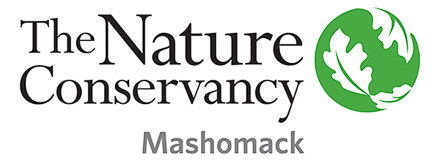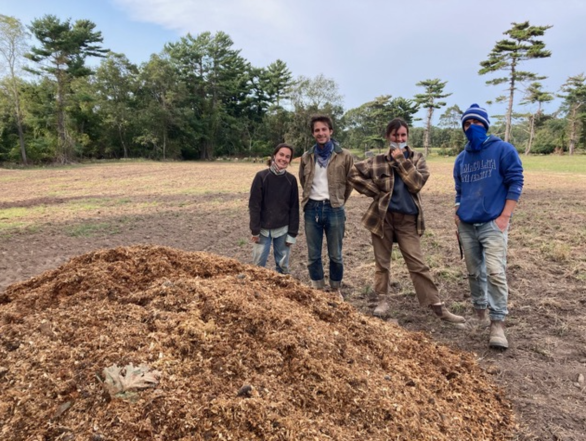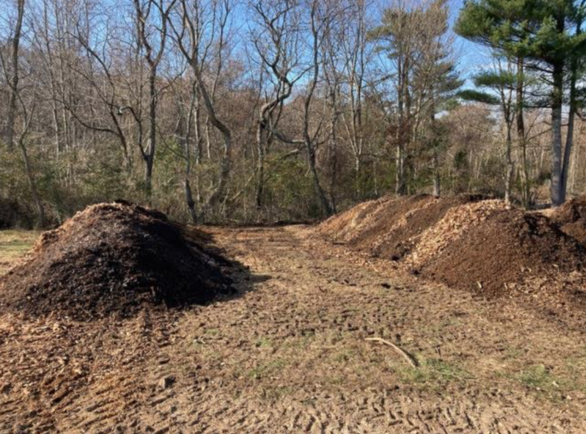

———————

A Partnership Between Two Shelter Island Organizations:
Sylvester Manor Educational Farm
and The Nature Conservancy’s Mashomack Preserve
—————————
A Collaborative Effort to Sustainably Manage Green and Brown Waste on Shelter Island
The Nature Conservancy’s Mashomack Preserve and Sylvester Manor Educational Farm are working together to establish a closed loop system of carbon cycling on Shelter Island. This partnership will optimize the use of the Preserve’s supply of carbon-rich materials (leaves and wood chips) by turning them into compost at Sylvester Manor.
Sylvester Manor currently cultivates 3 acres of vegetables and plans to expand their crop production by an additional 3 acres in 2021. Under the direction of Director of Farm Operations Cristina Cosentino, the farm will transition towards regenerative vegetable production and reduced tillage. These practices are hugely beneficial to building soil health, sequestering carbon, and reducing reliance on fossil fuels, but require large volumes of organic matter in the form of compost. To meet the farm’s soil fertility needs, Sylvester Manor is implementing a large-scale composting program.
The first step in this initiative was a Soil Fertility and Compost Program Planning internship funded by the Ida and Robert Gordon Family Foundation. 2020 Farm Apprentice Delaney Sondag filled this role, coming to Sylvester Manor with experience managing food waste at Baldor Foods. According to Delaney, “securing a continuous supply of chemical-free carbon-rich material is critical to producing compost and has proven to be a challenge on the Island.”
The fallen leaves and brush in Mashomack’s 2,039 acres of natural lands are the perfect source of carbon feedstock for composting. Alex Novarro, Conservation and Outreach Manager at Mashomack Preserve, states “we’re excited that composting these materials will help Sylvester Manor enrich its soil, making it more fertile and better able to absorb carbon pollution from the atmosphere. In that way, the program is a win for everyone. And it’s a win for us, too, because removing fallen branches and leaves from our Manor House complex reduces the risk of preserve visitors coming into contact with ticks, and by extension, helps to protect public health on Shelter Island.”
Food waste from Mashomack will also be composted at Sylvester Manor. The long-term goal is to expand this program to Shelter Island residents in an effort to redirect food waste to the farm’s compost. Sylvester Manor will begin composting food scraps from staff, board members and CSA members in 2021.
This collaborative effort furthers both organizations’ mission to combat climate change, improve land management practices and turn green and brown waste into a resource. Together, both organizations hope to move Shelter Island in the direction of establishing a scalable compost system that recycles and returns nutrients back to the soil.



~~~~~~~~~~~~~~~~~~~~~~~~~~

Sylvester Manor Educational Farm: Once a Native American hunting, fishing and farming ground, Sylvester Manor has since 1651 been home to eleven generations of its original European settler family. Gifted to the Shelter Island community in 2014, the 235-acre historic site is the most intact slaveholding plantation remnant north of Virginia.
Sylvester Manor sits on Gardiners Creek and has been transformed to an Enlightenment-era farm, then to a pioneering food industrialist’s estate and today to a nonprofit organic educational farm and vibrant arts and education center with programs open to all. The property includes the original Manor House built in 1735, a timber frame farmstand and a 19th century windmill. For more information, visit www.sylvestermanor.org.
———————
======================================

AAQ / Resource: Westhampton Architectural Glass
_________________________________________________
